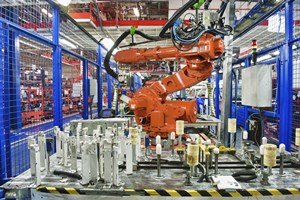 When determining the best solutions for safeguarding machinery and equipment, one of the biggest challenges that OSH professionals face is answering the question, “How safe is safe enough?” With so many potential risks and hazards associated with machinery, it can be difficult to know where to begin and which safeguards to put in place.
When determining the best solutions for safeguarding machinery and equipment, one of the biggest challenges that OSH professionals face is answering the question, “How safe is safe enough?” With so many potential risks and hazards associated with machinery, it can be difficult to know where to begin and which safeguards to put in place.
The ANSI B11 series of standards provides safety professionals a framework to identify and address issues of machinery safety and machine guarding through a task-based risk assessment. In addition, these standards offer general, performance and safety requirements for both machinery and integrated manufacturing systems (IMS).
“Although there are a number of other ANSI machine specific safety standards (e.g., robots, packaging machinery, woodworking machines and plastics or rubber processing machines), the ANSI B11 series is by far the most extensive portfolio of machinery safety standards,” says David Felinski, president of B11 Standards, Inc. “The B11 series includes all three standard types (from general safety “type-A” standards to machine-specific “type-C” safety standards) and are used both by employers to help them provide a safer workplace for employees and by manufacturers to help them build safer machines.”
The task-based approach described in ANSI B11.0-2015, Safety of Machinery; General Requirements & Risk Assessment, focuses on identifying the individuals who will interact with the machine or equipment, the tasks they have to perform and the hazards associated with those tasks. In this way, safety professionals can engage with those most familiar with the risks and hazards associated with equipment and machinery in order to collectively determine which would be the best solution(s).
The key is determining an acceptable level of risk for the stakeholders involved (e.g. suppliers, manufacturers, users) and the best and most feasible solutions for achieving that. Acceptable risk will depend on several factors including the application, working environment, technical capabilities, personnel and budget, among others.
Depending on the nature of the application, different safeguards can be sufficient for achieving acceptable risk. For example, if a facility has a high personnel turnover rate, a fixed guard on a machine can be a suitable solution. This is particularly true if the organization lacks technical capability to install, maintain and troubleshoot a control such as a safety light curtain.
Conversely, if the machine is in a laboratory setting with few personnel who are well-trained and familiar with the hazards, one could argue that a warning sign may be sufficient to achieve acceptable risk.
These are all factors for safety professionals to consider when facilitating the risk assessment process and determining the most appropriate safeguards. The ANSI B11.19-2010 standard, Performance Requirements for Safeguarding, provides guidance in this matter by allowing stakeholders to understand what a particular safeguard will be required to do if it is put in place. By examining these requirements, stakeholders can assess the impact of different safeguards and whether they will be able to achieve acceptable risk.
It is important to note that while the B11.19 standard offers different options for machine guarding and their required design and operation, it does not advise as to which should be used in a particular application or situation. That decision is addressed by the risk assessment, or, if available, one of the many machine specific “type-C” standards which complete the canon of B11 standards.
Safety professionals should also keep in mind that this should be an iterative process that considers the perspectives of all the different stakeholders to fully understand the risks and hazards and risks and how they can best be addressed.
“The safety professional doesn’t necessarily need to own the entire process,” explains Bruce Main, chair of the ANSI B11.0, Safety of Machinery, subcommittee. “What they do need to do is understand risk assessment, identify hazards and engage with engineers and others to get their input on how to reduce risks to an acceptable level.”
Moving beyond machinery and equipment, safety professionals must also consider the risks of IMS and the hazards that are created when individual machines are integrated into a larger system. ANSI B11.20-2017, Safety Requirements for Integrated Manufacturing Systems, establishes requirements for the construction, operation and maintenance of IMS.
When individual equipment and machines are integrated into an IMS, new risks and hazards are created that did not exist previously. For example, if a facility has a press that is used to compress parts, that presents its own risks and hazards. However, if a conveyor were placed next to that press, along with a robot that takes parts away, there now exists an IMS with new risks and hazards created by putting these different elements together.
The B11.20-2017 standard walks safety professionals through a process for evaluating an IMS to identify any newly created hazards and risks in order to put the proper safeguards in place to mitigate or eliminate them. In addition, given the wide variety of equipment and machinery that could go into an IMS, B11.20-2017 can be applied in many different applications.
Taken together, the B11 series of standards can help safety professionals and stakeholders conduct a comprehensive task-based risk assessment and install safeguards that achieve an acceptable level of risk for all involved.
Understanding Risk Management and Assessment
We have the resources and expert guidance you need to improve how you assess risks to prevent hazards, protect workers and safeguard equipment.
Learn more